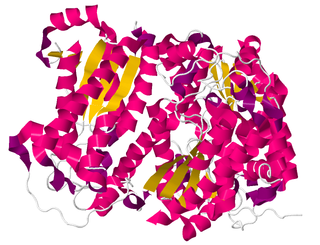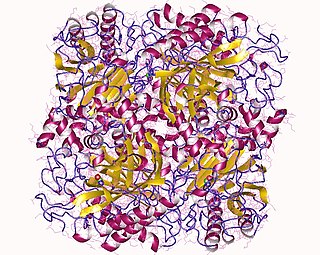In molecular biology, biosynthesis is a multi-step, enzyme-catalyzed process where substrates are converted into more complex products in living organisms. In biosynthesis, simple compounds are modified, converted into other compounds, or joined to form macromolecules. This process often consists of metabolic pathways. Some of these biosynthetic pathways are located within a single cellular organelle, while others involve enzymes that are located within multiple cellular organelles. Examples of these biosynthetic pathways include the production of lipid membrane components and nucleotides. Biosynthesis is usually synonymous with anabolism.

In enzymology, an amidase (EC 3.5.1.4, acylamidase, acylase (misleading), amidohydrolase (ambiguous), deaminase (ambiguous), fatty acylamidase, N-acetylaminohydrolase (ambiguous)) is an enzyme that catalyzes the hydrolysis of an amide. In this way, the two substrates of this enzyme are an amide and H2O, whereas its two products are monocarboxylate and NH3.
Acyl-homoserine-lactone acylase (EC 3.5.1.97, acyl-homoserine lactone acylase, AHL-acylase, AiiD, N-acyl-homoserine lactone acylase, PA2385 protein, quorum-quenching AHL acylase, quorum-quenching enzyme, PvdQ, QuiP) is an enzyme with systematic name N-acyl-L-homoserine-lactone amidohydrolase. This enzyme functions as a quorum quencher by catalysing the following chemical reaction
Sphingomyelin deacylase (EC 3.5.1.109, SM deacylase, GcSM deacylase, glucosylceramide sphingomyelin deacylase, sphingomyelin glucosylceramide deacylase, SM glucosylceramide GCer deacylase, SM-GCer deacylase, SMGCer deacylase) is an enzyme with systematic name N-acyl-sphingosylphosphorylcholine amidohydrolase. This enzyme catalyses the following chemical reaction




